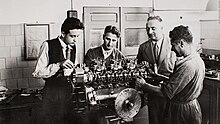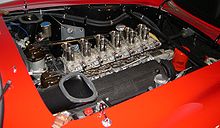Ferrari Colombo engine
This article needs additional citations for verification. (December 2018) |
Water-cooled | |
| Output | |
|---|---|
| Power output | 116–395 hp (87–295 kW; 118–400 PS) |
| Torque output | 90–240 lb⋅ft (122–325 N⋅m) |
| Chronology | |
| Successor | Ferrari Lampredi V12 engine Ferrari flat-12 engine Ferrari F116 engine |
The Ferrari Colombo Engine was a
Colombo, who had previously designed
Enzo Ferrari had long admired the V12 engines of
125



The first Ferrari-designed engine was the 1,496.77 cc (1.5 L; 91.3 cu in) V12 125, the work of Gioacchino Colombo and assistants
Colombo and Ferrari had designed the engine with
For 1949, the engine was further modified with
Applications:
- 1947 Ferrari 125 S — 118 PS (116 hp; 87 kW)
- 1948 Ferrari 125 F1 — Single supercharger, 230 PS (227 hp; 169 kW)
- 1949–1950 Ferrari 125 F1 — Dual-stage supercharger, 280 PS (276 hp; 206 kW)
58.8 mm stroke



The early 166, 195, and 212 cars used Colombo V12s of varying sizes. All shared the same 58.8 mm (2.31 in)
250
One of the most common Colombo engines is the 250, which debuted in 1952 in the 250S and lasted through the 1963 330 America. It used a 73 mm (2.87 in) bore with the common Colombo stroke of 58.8 mm (2.31 in) for a total of 2,953 cc (3.0 L).
Beginning with the famous 250 TR, "Testa Rossa" racing car, Ferrari began a new series of modifications to the Colombo 250 engine. The spark plugs were moved to the outside of the cylinder head, near the exhausts. This enabled Ferrari to introduce separate individual intake ports to use with the six two barrel Weber carburetors. Four cylinder head bolts per cylinder were introduced (instead of three) to cope with the added power.[6]
These changes eventually were incorporated into the Ferrari road cars, beginning with the 250 GT SWB and the 250 GT Series II Pininfarina cars.[7][8]
275
The final 58.8 mm (2.31 in) Colombo Ferrari was the 275. It used a 3,286 cc (3.3 L; 200.5 cu in) variant of the V12 with a wide 77 mm (3.03 in) bore for up to 300 PS (296 hp; 221 kW).
330
The 1960 400 Superamerica replaced the previous model's Lampredi engine with a 3,967 cc (4.0 L; 242.1 cu in) Colombo. It diverged from the standard 58.8 mm (2.31 in) stroke with a 71 mm (2.80 in) stroke and 77 mm (3.03 in) bore. Output was 340 to 400 PS (335 to 395 hp; 250 to 294 kW) with triple Weber carburetors.
Although the 1963 330 series also used a 3,967 cc (4.0 L; 242.1 cu in) engine with the same bore and stroke as the 400 Superamerica, this 300 PS (221 kW; 296 hp) engine was quite different. It used a wider bore spacing, paving the way for future displacement increases. The spark plugs were moved and a new water pump was used. The dynamo on the prior versions was replaced by an alternator.
Four-cam
The Colombo V12 was substantially reworked for 1967's
365
The 330 Colombo engine was enlarged with an 81 mm (3.19 in) bore to 4,390.35 cc (4.4 L; 267.9 cu in) for 1966's 365 California, retaining single overhead cams and wet sump lubrication. A reworked engine with four camshafts was used in the GT/4 models. The 365 GTB/4 Daytona was the only 365 engined car featuring dry sump lubrication.
Applications:
- 1966–1967 365 California
- 1968–1970 365 GTC, 365 GTS
- 1968–1972 365 GT 2+2
- 1968–1973 365 GTB/4 Daytona, 365 GTS/4 Daytona
- 1971–1972 365 GTC/4
- 1972–1976 365 GT4 2+2
400, 412
The wet sump, four-cam, 365 Colombo engine was enlarged again to 4,823.16 cc (4.8 L; 294.3 cu in) for 1976's
Applications:
- 1976–1979 400
- 1979–1985 400i
- 1986–1988 412i
See also
References
- ^ a b "Ferrari 125 S". ferrari.com. Retrieved 11 July 2019.
- ^ "Ferrari 330 GT 2+2". Ferrari. Retrieved 16 June 2015.
- ^ Shea, Terry (September 2014). "1964 Ferrari 330 GT". Hemmings Motor News. American City Business Journals. Retrieved 16 June 2015.
- ISBN 9780760325506.
- ^ "The Story of the V12: The Engine That Made Ferrari". JBR Capital. Retrieved 2018-04-23.
- ^ "Ferrari 250 GT Zagato". FineSportsCars.com. Archived from the original on 2021-01-08. Retrieved 2020-05-31.
- ^ "Ferrari 250 GT Berlinetta Passo Corto". myAutoWorld. Retrieved 2020-05-31.
- ^ "Ferrari 250 GT Series II Story". Collezione by MS. Archived from the original on 2018-08-27. Retrieved 2020-05-31.
Bibliography
- Colombo, Gioachino (1985). Origins of the Ferrari Legend. Sparkford Nr. Yeovil, Somerset BA22 7JJ: Haynes Publishing Group. ISBN 0-85429-624-7.)
{{cite book}}: CS1 maint: location (link
